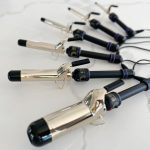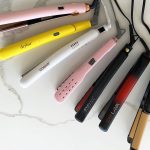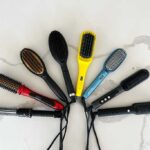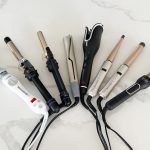From plate materials and size to additional features, we’ll guide you through all the details of choosing the best flat iron for your needs

A flat iron is a versatile tool that can help you achieve bone-straight styles, messy beachy waves, and curls effortlessly. We all know that choosing the perfect flat iron for your hair is not simple. There’s just way too many different brands and models on the market. But where to even start, right?
Whether you have fine or thick hair, are a complete beginner shopping for your first flat iron, or are looking to upgrade your old one, this article is for you. We will provide you with the most comprehensive information and walk you through everything you need to know. You’ll find tips and advice about choosing the right flat iron, from materials and features to price and warranty!
Plate Size
Flat irons come in a big range of sizes, varying from 1/2 inch to 2.5-inches.
Choosing the right iron size for you will depend on may factors including your curl pattern, density, length of hair, and desired results.
Rules in a Nutshell
- For thick, coarse hair, your straightening iron should have 1-inch or larger plates. Larger plates allow you to straighten hair faster, but they compromise the tightness of curls.
- For fine or damaged hair, stick to plates that are 1 inch or smaller. Smaller-sized flat irons apply less heat to the hair compared to larger plate irons.
- Smaller-sized flat iron plates provide a firmer grip for precision and straightening.
Smaller Options:
Plates that range from 0.5 inches to 0.75 inches are considered small.
Who is it for?
- Pixie/short haircuts, bangs, edges, and finishing touches
- Travel purposes
- Fine to normal hair texture
Pros:
- Perfect for creating tight curls
- Can reach very close to the roots
- Provides extra precision and control
- Easier to hold and maneuver
Cons:
- Takes longer to style if you have thick, dense, or long hair
Standard Size:
1-inch plates are the most commonly used and found ones on the market. Here’s the reason why:
Who Is It For?
- For all hair types and lengths
- Seeking versatile use
Pros:
- Strikes a great balance between time efficiency and effectiveness
- Create a variety of waves and curls
- Maintains a firmer grip than larger sizes
- Creates more root volume than smaller sizes
- Easy to handle with large or small hands
Cons:
- Can not get as close to the roots compared to smaller-sized irons
- It takes longer to style thicker or longer hair compared to wider plates
- Does not provide precision and control as effectively as smaller plates
Larger Plates:
Plates that range from 1.25 inches to 2.5 inches are considered large.
Who Is It For?
- Straightening thick and long hair faster
- 1.5-inch wide plates are perfect for creating beach waves
- Not for styling neck length or shorter hair
- Not for fine or damaged hair
Pros:
- Provides faster styling with more coverage
- Creates sleek and smooth styles with less effort
- Less risk of burning the scalp
Cons:
- Not suitable for precise styling
- Higher risk of heat damage
- Can be tiring to use for long periods due to weight
- Challenging to control for those with small hands
Bottom Line:
Are you still having doubts about which plate to choose? Then we recommend 1-inch plates as they are the most versatile and work on all hair types.
Heat Control
Another important thing to think about before choosing is temperature control.
Remember! Flat irons with more temperature settings and a wider range allow for better control.
How To Choose Wisely
- If you have fine or fragile hair, opt for a starting temperature of 250°F or lower
- For thick and stubborn hair, look for a higher temperature, up to 450°F
- To ensure safety, look for a model that allows you to adjust the temperature in increments of 10°F or 15°F
- For beginners, a flat iron with a smart microchip that adjusts the temperature according to hair type is the safest choice
Bottom Line:
Don’t forget that the right setting will depend on your hair type, length, health condition, and more. When in doubt, always start with a lower temperature and gradually increase to find the right heat level.
Plate Material
Flat irons are mostly made of ceramic, tourmaline, or titanium.
Ceramic Plates:
At lower temperatures, ceramic plates perform better than titanium.
This is because ceramic plates can evenly retain and distribute low heat, avoiding hot and cold spots. As a result, they provide a gentler and safer styling session.
Who Is It For?
- Fine, thin, or dry hair
- Damaged, colored & chemically treated hair
- Beginners
- Everyday use
- Styling with low to moderate heat
Pros:
- Provides a more gentle hair styling session
- Less heat damage risk
- Creates uniformly straightened strands
- Heats up slowly, making it easier to regulate the temperature
Cons:
- More fragile than other materials and may crack or chip
- Takes longer to heat up
Titanium Plates:
Titanium flat irons offer faster and longer-lasting styling results compared to ceramic.
They are designed to heat up quickly and maintain consistent high temperatures. This makes titanium effective for styling coarse or thick hair efficiently.
Who Is It For?
- Thick, coarse, and high-heat-tolerant hair
- Taming unruly curls and coils
- Professionals
- Seeking a quick styling session
Pros:
- Naturally durable and lightweight compared to ceramic
- Heats up faster than ceramic
- Delivers faster results with the highest level of heat
Cons:
- Costlier than ceramic plates
- Higher heat damage risk
Tourmaline-Infused Plates:
This material is found as a crystal coating infused in ceramic or titanium plates. The straighteners are not available as purely made out of tourmaline.
This option provides all of the benefits of the material underneath, plus tourmaline’s unbeatable frizz-reducing properties.
Who Is It For?
- People who struggle with frizzy and dry hair
- Those living in humid environments
Pros:
- Tourmaline ceramic flat irons considered the least damaging
- Provides the smoothest finish among all options
- Offers quick and even heat distribution
- Straightens hair at lower temperatures compared to ceramic or titanium plates
Cons:
- More expensive than other materials
- Less durable compared to titanium plates
Aluminum Plates:
We don’t recommend aluminum plates, as they can damage the hair.
They have a reputation to heat up unevenly and create hot spots that can cause damage to the hair.
You may also like: titanium vs ceramic, flat irons for curly hair
Don’t forget to check out the Best Straighteners for natural hair and coils
High-Tech Features
Wet To Dry Irons
Traditional flat irons should be used on completely dry hair, whereas “wet to dry” irons are designed to straighten hair whether it’s damp or dry. They feature a venting system that removes excess water as steam while you style. Wet to dry irons reduce the time and effort needed to style hair.
Who Is It For?
“Wet to dry” irons are ideal for people with very curly, coily, or unruly hair that becomes difficult to manage once fully dried or those looking for quicker styling solutions. These irons help reduce frizz and achieve smoother hair.
Floating Plates
Floating plates sit on springs instead of being completely fixed to their base. These springs allow the plates to tilt at different angles, provide 100% contact with hair. This helps you style faster and with fewer passes.
It also minimizes hair pulling and snagging, which reduces the risk of hair breakage and damage.
Memory Function
A flat iron memory function saves your preferred heat settings and remembers every time you switch on. You don’t need to adjust the temperature every time.
Smart Microchip
A smart microchip maintains stable heat by consistently controlling the temperature. Enhanced versions can automatically adjust the temperature based on your hair’s texture and thickness. This helps protect hair from overheating and reduces the risk of damage and breakage.
Other Considerations
Ion generator
Frizz comes from positive ions in the hair. If you live in a humid place, have dry or damaged hair due to chemical treatments, or use heat styling often, you may struggle with frizz. An ion generator can help by neutralizing these ions, making your hair smoother and easier to manage.
However, frizz can be beneficial for fine and thin hair as it adds volume. Removing all frizz with an ion generator can make hair look limp.
Automatic Shut-Off
Automatic shut-off is a helpful feature that turns off the flat iron after about 30 minutes. It’s designed to prevent accidents and is commonly found in consumer-grade flat irons.
Professional hot tools usually don’t have this feature because they’re used constantly without breaks.
Digital Heat Settings
Buttons provide a more secure and easy way to adjust settings compared to manual wheels, which can be accidentally changed.
LED Display
A digital LED display on a flat iron lets you control temperature settings precisely. It’s easy to read and provides clear and accurate temperature information.
Dual Voltage
Dual voltage is a great feature to invest in if you travel often! It allows the flat iron to be used in any country overseas, with options to switch between 110V and 220V settings.
Ergonomic Design
An ergonomically designed flat iron enables you to achieve salon-quality results at home.
Look for these qualities while making your decision;
- 360° free-movement swivel cord that allows for easy maneuvering
- a professional-length cord that won’t get tangled
- a non-slip grip that ensures smooth and consistent results
- a cool-tip is also great to have for preventing burns and easy maneuverability
- a lightweight design that makes it easy to grip and control
Wrap Up
Every individual has different priorities when it comes to choosing the best flat iron. It’s important to consider the features that are most important for you.
With so many options available in the market to suit individual needs, you can find the right one for your hair type and styling preferences in no time!




